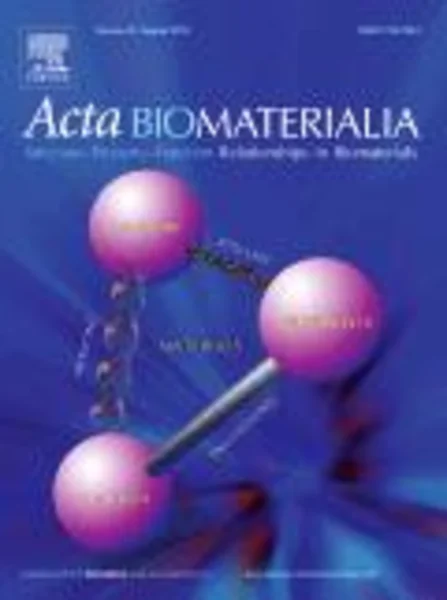-
effect of self-assembled nanofibrous silk/polycaprolactone layer on the osteoconductivity and mechanical properties of biphasic calcium phosphate scaffolds
جزئیات بیشتر مقاله- تاریخ ارائه: 1392/01/01
- تاریخ انتشار در تی پی بین: 1392/01/01
- تعداد بازدید: 719
- تعداد پرسش و پاسخ ها: 0
- شماره تماس دبیرخانه رویداد: -
we here present the first successful report on combining nanostructured silk and poly(ε-caprolactone) (pcl) with a ceramic scaffold to produce a composite scaffold that is highly porous (porosity ∼85%, pore size ∼500 μm, ∼100% interconnectivity), strong and non-brittle with a surface that resembles extracellular matrix (ecm). the ecm-like surface was developed by self-assembly of nanofibrous structured silk (20–80 nm diameter, similar to native collagen found in ecm) over a thin pcl layer which is coated on biphasic calcium phosphate (bcp) scaffolds. the effects of different concentrations of silk solution on the mechanical and physical properties of the scaffolds were also comprehensively examined. our results showed that using silk only (irrespective of concentration) for the modification of ceramic scaffolds could drastically reduce the compressive strength of the modified scaffolds in aqueous media, and the modification made a limited contribution to improving scaffold toughness. using pcl/nanostructured silk the compressive strength and modulus of the modified scaffolds reached 0.42 mpa (compared with 0.07 mpa for bcp) and ∼25 mpa (compared with 5 mpa for bcp), respectively. the failure strain of the modified scaffold increased more than 6% compared with a bcp scaffold (failure strain of less than 1%), indicating a transformation from brittle to elastic behavior. the cytocompatibility of ecm-like composite scaffolds was investigated by studying the attachment, morphology, proliferation and bone-related gene expression of primary human bone-derived cells. cells cultured on the developed scaffolds for 7 days had significant up-regulation of cell proliferation (∼1.6-fold higher,p < 0.001) and osteogenic gene expression levels (collagen type i, osteocalcin and bone sialoprotein) compared with the other groups tested.
مقالات جدیدترین رویدادها
-
استفاده از تحلیل اهمیت-عملکرد در ارائه الگوی مدیریت خلاقیت سازمانی و ارائه راهکار جهت بهبود
-
بررسی تاثیر ارزش وجوه نقد مازاد بر ساختار سرمایه شرکت های پذیرفته شده در بورس اوراق بهادار تهران
-
بررسی تأثیر سطح افشای ریسک بر قرارداد بدهی شرکت های پذیرفته شده در بورس اوراق بهادار تهران
-
بررسی تأثیر رتبه بندی اعتباری مبتنی بر مدل امتیاز بازار نوظهور بر نقد شوندگی سهام با تأکید بر خصوصی سازی شرکت ها
-
تأثیر آمیخته بازاریابی پوشاک ایرانی بر تصویر ذهنی مشتری پوشاک ایرانی (هاکوپیان)
-
درس پژوهی یادگیری ساعت_ ربع و نیم ریاضی دوم
-
معرفی جاذبه های طبیعی استان گیلان مطالعه موردی شهرستان رضوانشهر
-
بررسی آزمایشگاهی تاثیر آب شکن فرعی قائم بر آب شستگی دماغه ی اولین آب شکن
-
turbulent forced convection heat transfer of non-newtonian nanofluids
-
facile fabrication of recoverable and stable superhydrophobic polyaniline films
مقالات جدیدترین ژورنال ها
-
مدیریت و بررسی افسردگی دانش آموزان دختر مقطع متوسطه دوم در دروان کرونا در شهرستان دزفول
-
مدیریت و بررسی خرد سیاسی در اندیشه ی فردوسی در ادب ایران
-
واکاوی و مدیریت توصیفی قلمدان(جاکلیدی)ضریح در موزه آستان قدس رضوی
-
بررسی تاثیر خلاقیت، دانش و انگیزه کارکنان بر پیشنهادات نوآورانه کارکنان ( مورد مطالعه: هتل های 3 و 4 ستاره استان کرمان)
-
بررسی تاثیر کیفیت سیستم های اطلاعاتی بر تصمیم گیری موفق در شرکتهای تولیدی استان اصفهان (مورد مطالعه: مدیران شرکتهای تولیدی استان اصفهان)
-
ارتباط ارزهای دیجیتال با اوراق بهادار
-
استراتژی توسعه شهر شیروان با رویکرد توسعه پایدار
-
طراحی مدلی برای شناسایی فرصت های کارآفرینی در مناطق بندری
-
مطالعه و بررسی تکنیک های سرد تزیین آثار شیشه ای
-
بررسی فرهنگ سازمانی معلمان ابتدایی




سوال خود را در مورد این مقاله مطرح نمایید :